Abstract
OBJECTIVE: To review the current literature on the dietary modification of urinary risk factors as a means of reducing the likelihood of recurrent stone formation and to develop practical dietary recommendations that might be useful to this end. DATA SOURCES: MEDLINE was searched for English-language articles published from 1983 to 1990. Additional references were selected from the bibliographies of identified articles. STUDY SELECTION: Nonrandomized trials and retrospective reviews were included because of a paucity of randomized controlled trials. DATA SYNTHESIS: Information on the dietary intake of calcium, oxalate, protein, sodium and fibre and on alcohol and fluid intake was used to develop practical guidelines on dietary modification. CONCLUSION: Dietary modification plays an important role in the reduction of urinary risk factors in patients with calcium stone disease of the urinary tract. As an initial form of prevention attention should be directed toward moderating the intake of calcium, oxalate, protein, sodium and alcohol and increasing the intake of fibre and water. Future research should include an assessment of the long-term reduction of dietary and urinary risk factors and the rates of recurrence of calcium stones.
Full text
PDF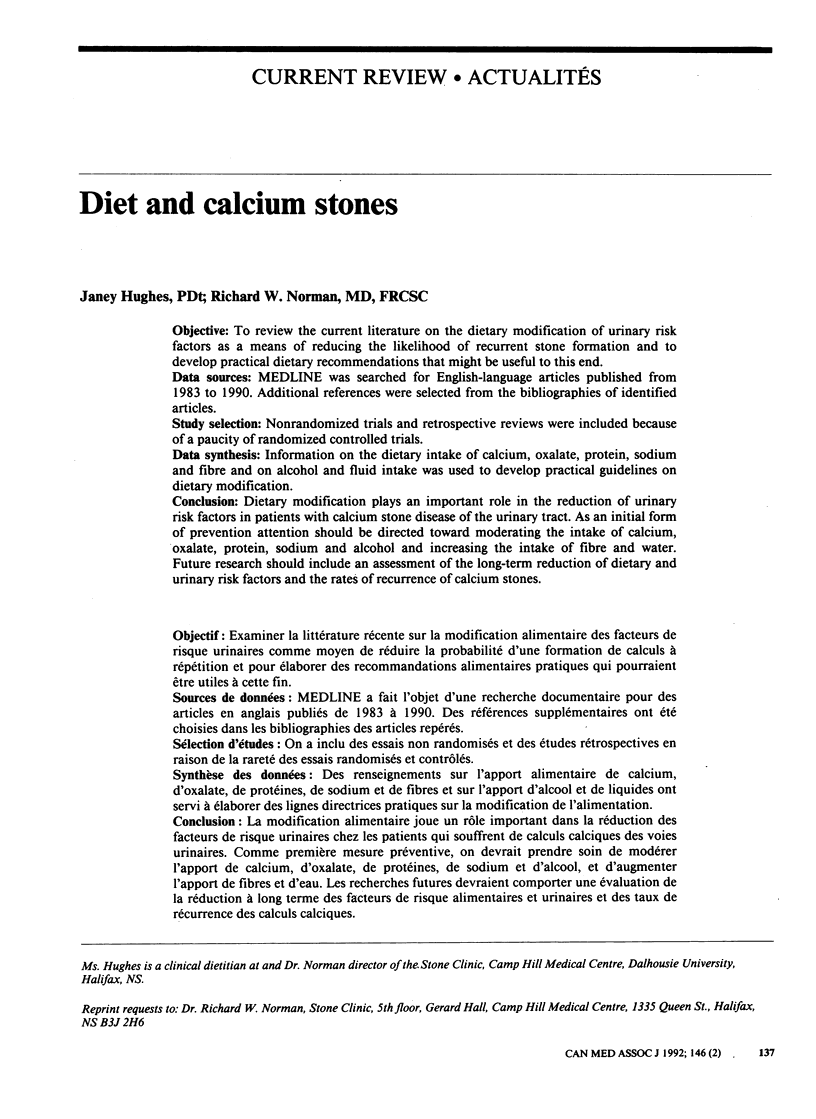
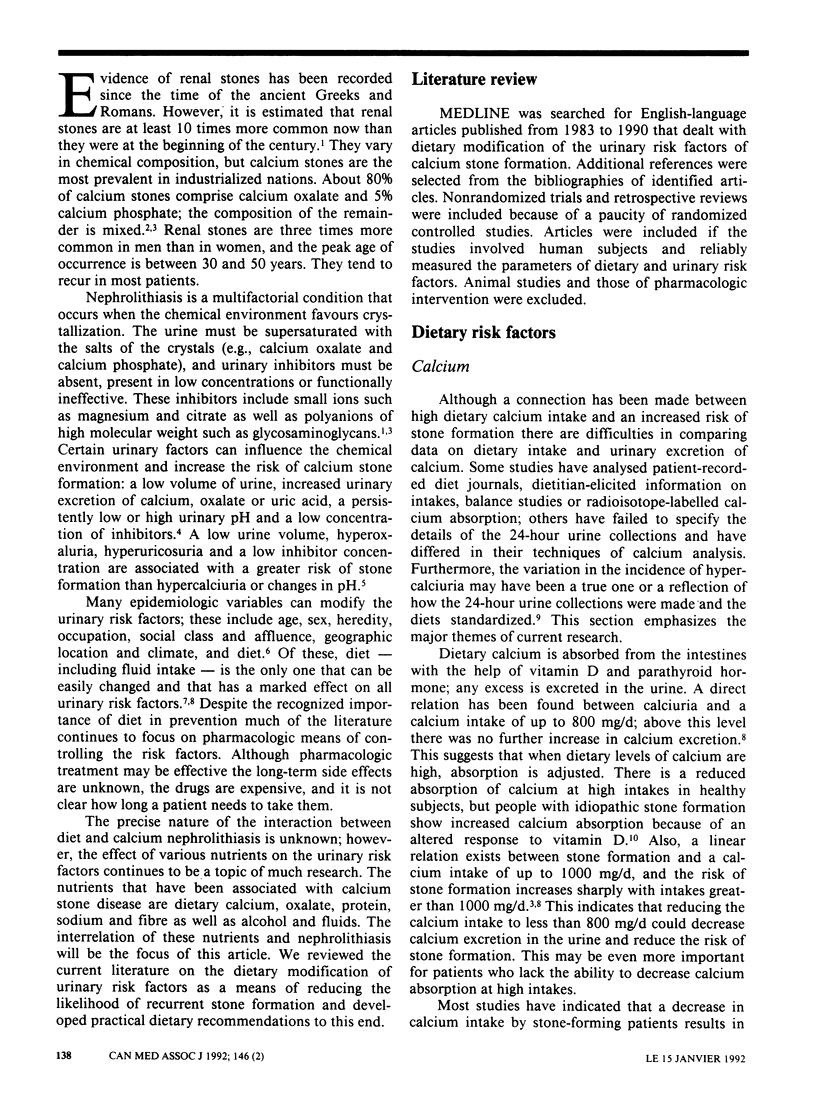
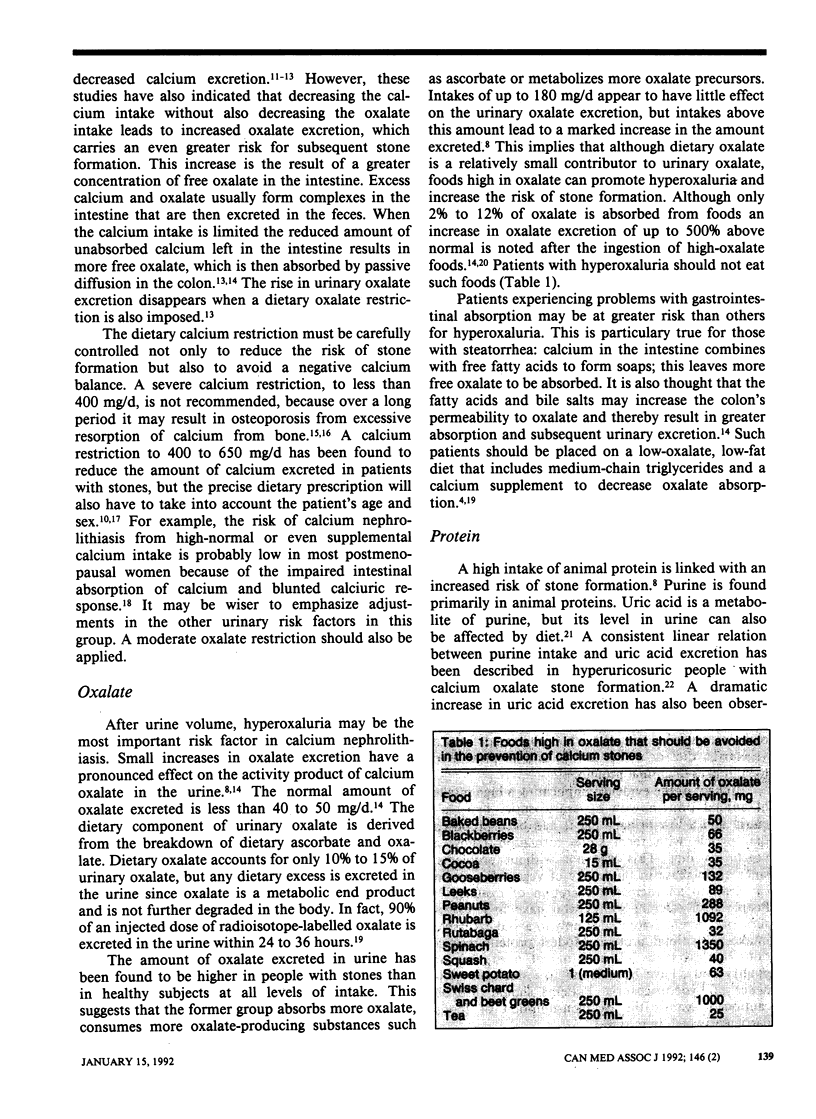
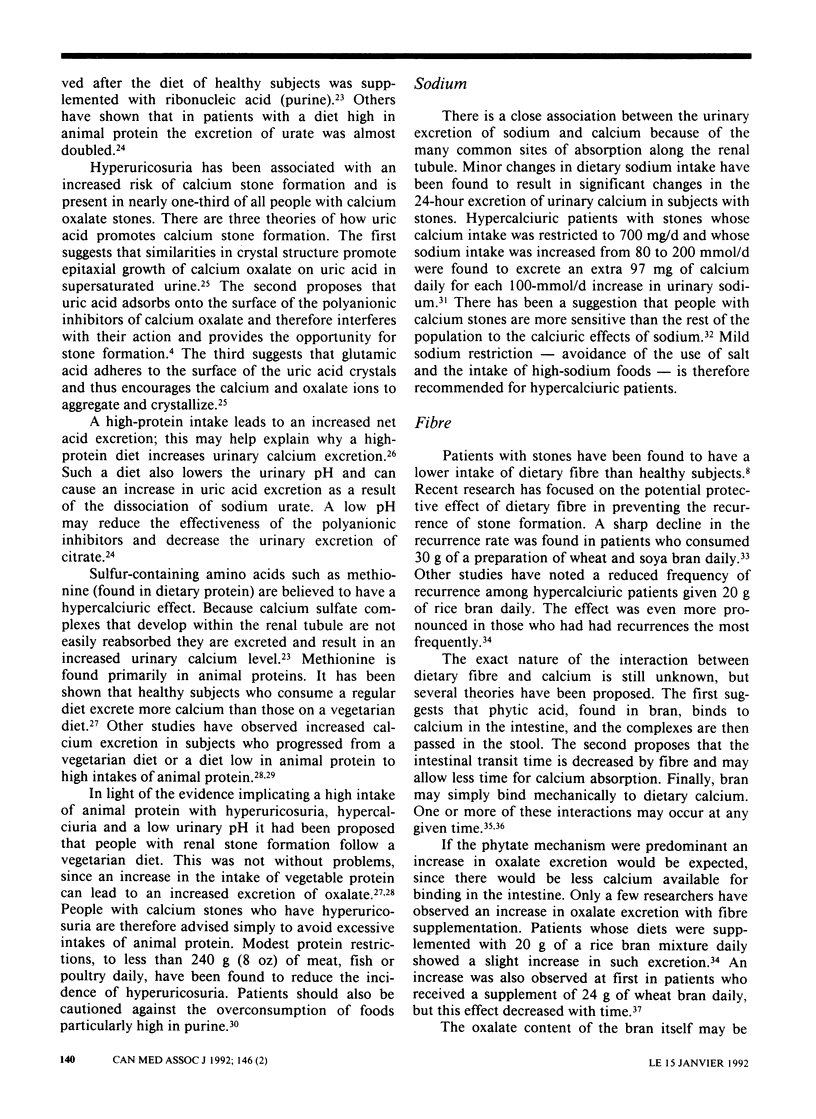

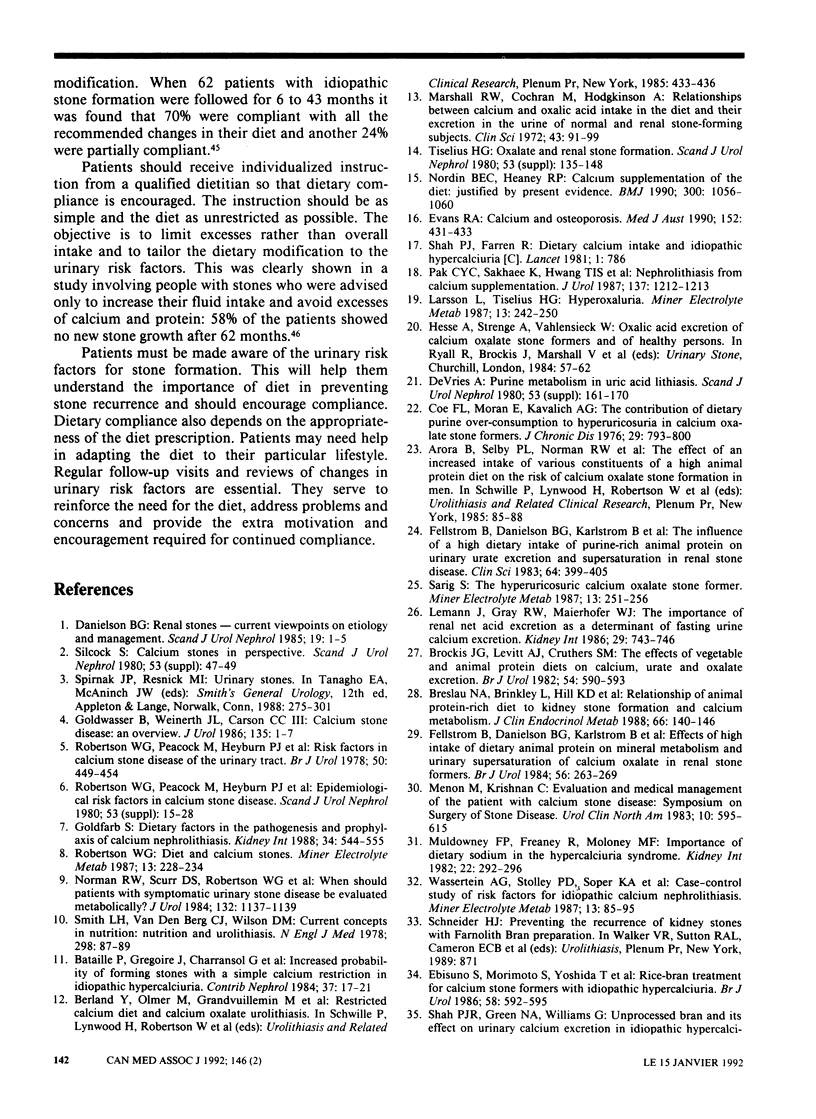

Selected References
These references are in PubMed. This may not be the complete list of references from this article.
- Bataille P., Gregoire J., Charransol G., Pruna A., Coevoet B., Fournier A. Increased probability of forming stones with a simple calcium restriction in idiopathic hypercalciuria. Contrib Nephrol. 1984;37:17–21. doi: 10.1159/000408542. [DOI] [PubMed] [Google Scholar]
- Breslau N. A., Brinkley L., Hill K. D., Pak C. Y. Relationship of animal protein-rich diet to kidney stone formation and calcium metabolism. J Clin Endocrinol Metab. 1988 Jan;66(1):140–146. doi: 10.1210/jcem-66-1-140. [DOI] [PubMed] [Google Scholar]
- Brockis J. G., Levitt A. J., Cruthers S. M. The effects of vegetable and animal protein diets on calcium, urate and oxalate excretion. Br J Urol. 1982 Dec;54(6):590–593. doi: 10.1111/j.1464-410x.1982.tb13602.x. [DOI] [PubMed] [Google Scholar]
- Coe F. L., Moran E., Kavalich A. G. The contribution of dietary purine over-consumption to hyperpuricosuria in calcium oxalate stone formers. J Chronic Dis. 1976 Dec;29(12):793–800. doi: 10.1016/0021-9681(76)90053-9. [DOI] [PubMed] [Google Scholar]
- Danielson B. G. Renal stones--current viewpoints on etiology and management. Scand J Urol Nephrol. 1985;19(1):1–5. doi: 10.3109/00365598509180213. [DOI] [PubMed] [Google Scholar]
- Ebisuno S., Morimoto S., Yoshida T., Fukatani T., Yasukawa S., Ohkawa T. Rice-bran treatment for calcium stone formers with idiopathic hypercalciuria. Br J Urol. 1986 Dec;58(6):592–595. doi: 10.1111/j.1464-410x.1986.tb05892.x. [DOI] [PubMed] [Google Scholar]
- Evans R. A. Calcium and osteoporosis. Med J Aust. 1990 Apr 16;152(8):431–433. doi: 10.5694/j.1326-5377.1990.tb125273.x. [DOI] [PubMed] [Google Scholar]
- Fellström B., Danielson B. G., Karlström B., Lithell H., Ljunghall S., Vessby B. The influence of a high dietary intake of purine-rich animal protein on urinary urate excretion and supersaturation in renal stone disease. Clin Sci (Lond) 1983 Apr;64(4):399–405. doi: 10.1042/cs0640399. [DOI] [PubMed] [Google Scholar]
- Fellström B., Danielson B. G., Karlström B., Lithell H., Ljunghall S., Vessby B., Wide L. Effects of high intake of dietary animal protein on mineral metabolism and urinary supersaturation of calcium oxalate in renal stone formers. Br J Urol. 1984 Jun;56(3):263–269. doi: 10.1111/j.1464-410x.1984.tb05384.x. [DOI] [PubMed] [Google Scholar]
- Gleeson M. J., Thompson A. S., Mehta S., Griffith D. P. Effect of unprocessed wheat bran on calciuria and oxaluria in patients with urolithiasis. Urology. 1990 Mar;35(3):231–234. doi: 10.1016/0090-4295(90)80038-o. [DOI] [PubMed] [Google Scholar]
- Goldfarb S. Dietary factors in the pathogenesis and prophylaxis of calcium nephrolithiasis. Kidney Int. 1988 Oct;34(4):544–555. doi: 10.1038/ki.1988.216. [DOI] [PubMed] [Google Scholar]
- Goldwasser B., Weinerth J. L., Carson C. C., 3rd Calcium stone disease: an overview. J Urol. 1986 Jan;135(1):1–9. doi: 10.1016/s0022-5347(17)45497-8. [DOI] [PubMed] [Google Scholar]
- Hosking D. H., Erickson S. B., Van den Berg C. J., Wilson D. M., Smith L. H. The stone clinic effect in patients with idiopathic calcium urolithiasis. J Urol. 1983 Dec;130(6):1115–1118. doi: 10.1016/s0022-5347(17)51711-5. [DOI] [PubMed] [Google Scholar]
- Larsson L., Tiselius H. G. Hyperoxaluria. Miner Electrolyte Metab. 1987;13(4):242–250. [PubMed] [Google Scholar]
- Lemann J., Jr, Gray R. W., Maierhofer W. J., Cheung H. S. The importance of renal net acid excretion as a determinant of fasting urinary calcium excretion. Kidney Int. 1986 Mar;29(3):743–746. doi: 10.1038/ki.1986.60. [DOI] [PubMed] [Google Scholar]
- Marshall R. W., Cochran M., Hodgkinson A. Relationships between calcium and oxalic acid intake in the diet and their excretion in the urine of normal and renal-stone-forming subjects. Clin Sci. 1972 Jul;43(1):91–99. doi: 10.1042/cs0430091. [DOI] [PubMed] [Google Scholar]
- Menon M., Krishnan C. S. Evaluation and medical management of the patient with calcium stone disease. Urol Clin North Am. 1983 Nov;10(4):595–615. [PubMed] [Google Scholar]
- Muldowney F. P., Freaney R., Moloney M. F. Importance of dietary sodium in the hypercalciuria syndrome. Kidney Int. 1982 Sep;22(3):292–296. doi: 10.1038/ki.1982.168. [DOI] [PubMed] [Google Scholar]
- Nordin B. E., Heaney R. P. Calcium supplementation of the diet: justified by present evidence. BMJ. 1990 Apr 21;300(6731):1056–1060. doi: 10.1136/bmj.300.6731.1056. [DOI] [PMC free article] [PubMed] [Google Scholar]
- Norman R. W., Bath S. S., Robertson W. G., Peacock M. When should patients with symptomatic urinary stone disease be evaluated metabolically? J Urol. 1984 Dec;132(6):1137–1139. doi: 10.1016/s0022-5347(17)50064-6. [DOI] [PubMed] [Google Scholar]
- Ohkawa T., Ebisuno S., Kitagawa M., Morimoto S., Miyazaki Y. Rice bran treatment for hypercalciuric patients with urinary calculous disease. J Urol. 1983 May;129(5):1009–1011. doi: 10.1016/s0022-5347(17)52512-4. [DOI] [PubMed] [Google Scholar]
- Pak C. Y., Sakhaee K., Crowther C., Brinkley L. Evidence justifying a high fluid intake in treatment of nephrolithiasis. Ann Intern Med. 1980 Jul;93(1):36–39. doi: 10.7326/0003-4819-93-1-36. [DOI] [PubMed] [Google Scholar]
- Pak C. Y., Sakhaee K., Hwang T. I., Preminger G. M., Harvey J. A. Nephrolithiasis from calcium supplementation. J Urol. 1987 Jun;137(6):1212–1213. doi: 10.1016/s0022-5347(17)44455-7. [DOI] [PubMed] [Google Scholar]
- Robertson W. G. Diet and calcium stones. Miner Electrolyte Metab. 1987;13(4):228–234. [PubMed] [Google Scholar]
- Robertson W. G., Peacock M., Heyburn P. J., Hanes F. A. Epidemiological risk factors in calcium stone disease. Scand J Urol Nephrol Suppl. 1980;53:15–30. [PubMed] [Google Scholar]
- Robertson W. G., Peacock M., Heyburn P. J., Marshall D. H., Clark P. B. Risk factors in calcium stone disease of the urinary tract. Br J Urol. 1978 Dec;50(7):449–454. doi: 10.1111/j.1464-410x.1978.tb06189.x. [DOI] [PubMed] [Google Scholar]
- Sarig S. The hyperuricosuric calcium oxalate stone former. Miner Electrolyte Metab. 1987;13(4):251–256. [PubMed] [Google Scholar]
- Shah P. J., Farren R. Dietary calcium intake and idiopathic hypercalciuria. Lancet. 1981 Apr 4;1(8223):786–786. doi: 10.1016/s0140-6736(81)92662-3. [DOI] [PubMed] [Google Scholar]
- Shah P. J., Green N. A., Williams G. Unprocessed bran and its effect on urinary calcium excretion in idiopathic hypercalciuria. Br Med J. 1980 Aug 9;281(6237):426–426. doi: 10.1136/bmj.281.6237.426. [DOI] [PMC free article] [PubMed] [Google Scholar]
- Silcock S. Calcium stones in perspective. Scand J Urol Nephrol Suppl. 1980;53:47–52. [PubMed] [Google Scholar]
- Smith L. H., Van Den Berg C. J., Wilson D. M. Nutrition and urolithiasis. N Engl J Med. 1978 Jan 12;298(2):87–89. doi: 10.1056/NEJM197801122980207. [DOI] [PubMed] [Google Scholar]
- Tiselius H. G. Oxalate and renal stone formation. Scand J Urol Nephrol Suppl. 1980;53:135–148. [PubMed] [Google Scholar]
- Tizzani A., Casetta G., Piana P., Vercelli D. Wheat bran in the selective therapy of absorptive hypercalciuria: a study performed on 18 lithiasic patients. J Urol. 1989 Oct;142(4):1018–1020. doi: 10.1016/s0022-5347(17)38973-5. [DOI] [PubMed] [Google Scholar]
- Wasserstein A. G., Stolley P. D., Soper K. A., Goldfarb S., Maislin G., Agus Z. Case-control study of risk factors for idiopathic calcium nephrolithiasis. Miner Electrolyte Metab. 1987;13(2):85–95. [PubMed] [Google Scholar]


